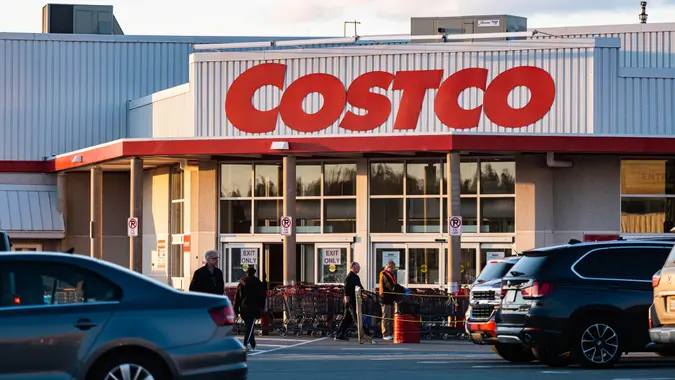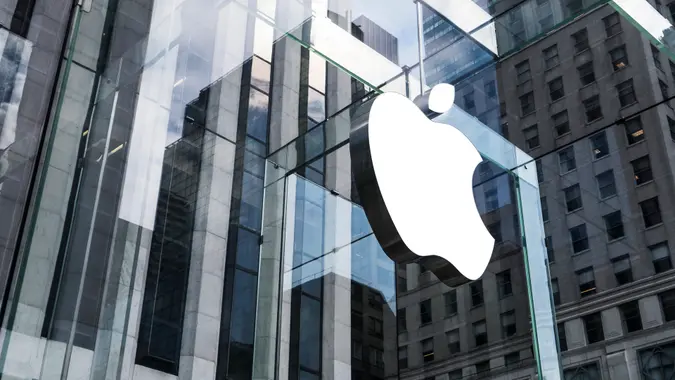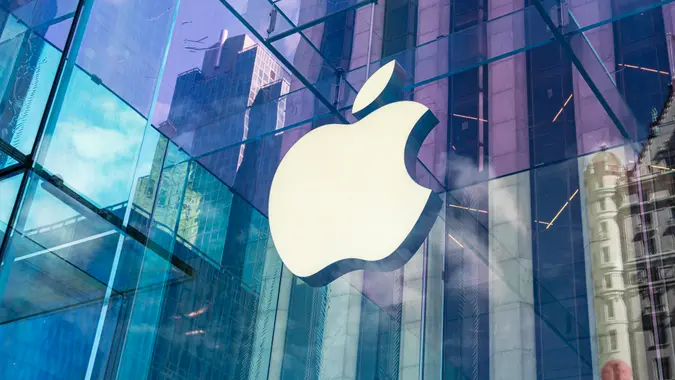Are Meta, Tesla and Amazon Stock Forecasts Making Investors Nervous?

Commitment to Our Readers
GOBankingRates' editorial team is committed to bringing you unbiased reviews and information. We use data-driven methodologies to evaluate financial products and services - our reviews and ratings are not influenced by advertisers. You can read more about our editorial guidelines and our products and services review methodology.

20 Years
Helping You Live Richer

Reviewed
by Experts

Trusted by
Millions of Readers
As the Tesla stock forecast trends negative, and Alphabet and Apple begin to dip, some may wonder whether investors are becoming less forgiving when it comes to disappointing results from U.S. tech giants. But what exactly could that mean for the U.S. economy?
See Also: 6 Genius Things All Wealthy People Do With Their Money
If Tech Stocks Fail, Will They Drag Down the Rest of the Market?
Although the S&P 500, an index of 500 of the top publicly traded companies in the U.S., keeps reaching all-time highs again and again, the forecast might not be entirely positive under the surface.
The S&P 500 index has become more and more concentrated in recent years, with a majority of the growth occurring among the top seven stocks. These stocks, often called the “Magnificent Seven,” are Nvidia, Apple, Microsoft, Amazon, Tesla, Alphabet and Meta.
What Is the S&P 500’s Concentration?
The value of the S&P 500 isn’t calculated based on the individual prices of the stocks that comprise it. Instead, it’s based on those companies’ “float-adjusted” market capitalization. This is the total value of a company’s publicly available stock. This means the public can buy and sell the stock.
Once you know the number of publicly available shares a company has, you can multiply that number by the share price to get the float-adjusted market capitalization. This is essentially the total dollar value of the portion of the company that’s available for the public to trade and invest in.
When someone says that the S&P 500 is becoming more and more concentrated, it means that a few companies have grown much more rapidly than others. Now, those companies’ total value makes up a larger portion of the total value of the index than before. When you buy a share of the S&P 500, around 30% of the dollar value of that share comes from just seven companies — the Magnificent Seven. Remember, the S&P 500 is an index of 500 companies, which themselves comprise around 75% of the U.S. economy.
In November 2023, Goldman Sachs warned that the S&P 500 index was more concentrated than it had ever been, with the top 10 stocks making up 32% of the total value. In the previous 35 years, the average was 20%, with a peak of 25% during the dot-com bubble.
Tech Stocks Drove Recent Growth — but It Might Not Last
As of February, the Magnificent Seven tech stocks were responsible for 40% of the S&P 500’s growth in 2024. Last year, when the S&P 500 rose 26%, these seven stocks were responsible for 62% of that growth. In investing, financial advisors often talk about the value of diversification — of not putting all of your eggs in one basket. Investing in a passive index fund is often viewed as investing in the overall market. However, because of the concentration of the top seven tech stocks in the S&P 500, when you invest in an S&P 500 index fund, your returns are now heavily reliant on a few tech companies.
The problem is that they aren’t all performing well anymore. Tesla has been on a downward trend for a while, with a recent dip after a dour earnings call in January. Apple has fallen almost 10% in the past month, and so has Alphabet, the parent company of Google. The Meta stock forecast seems less positive than before as the stock begins to trend sideways. Nvidia has experienced the most growth, with more than a 20% increase in value over the past month . Nvidia’s growth has been driven by the AI boom — its GPUs have become the shovels of the machine learning gold rush. If Nvidia’s growth slows, though, people’s investments are likely to suffer.
Is AI a Bubble?
Market bubbles are characterized by asset prices escalating far beyond their intrinsic value. This is fueled by speculative investor behavior, with the bubble eventually popping in a significant market correction. Nvidia’s rapid growth may raise concerns over whether these valuations are sustainable.
AI is a powerful new technology with incredible potential. However, the internet and online retail were also revolutionary, and not all companies that rose to prominence during the dot-com bubble survived. Amazon is the largest of the surviving dot-com companies, and the Amazon stock forecast is still positive, though growth has flattened.
Is Nvidia’s current valuation based solely on its sales and real potential, or has its rapid growth generated unrealistic expectations in the market? Monitoring economic indicators like price-to-earnings ratios and market sentiment toward AI is vital to gauge whether the current valuations are sustainable.
Our in-house research team and on-site financial experts work together to create content that’s accurate, impartial, and up to date. We fact-check every single statistic, quote and fact using trusted primary resources to make sure the information we provide is correct. You can learn more about GOBankingRates’ processes and standards in our editorial policy.
- Barrons. 2024. "Tesla, Nvidia, and the Magnificent 7 Are Macro Risks Now. What It Means for the S&P 500."
- Goldman Sachs. 2023. "Equity Index Concentration and Portfolio Implications."
- Axios. 2024. "The S&P’s top stocks haven’t been this concentrated in 50 years."
- Nasdaq. 2024. "The "Not So" Magnificent 7."
- Marketplace. 2024. "What you need to know about Nvidia and the AI chip arms race."
- Investor's B usiness Daily. 2023. "Amazon Stock Scores Bullish Price Target On Ad Business Potential."
 Written by
Written by  Edited by
Edited by 

























